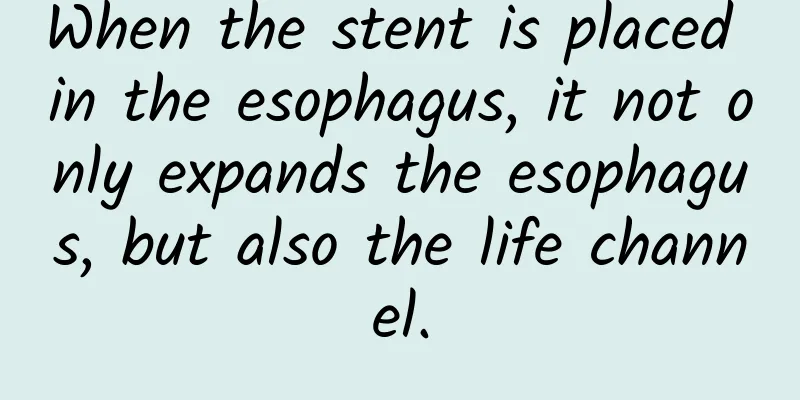When the stent is placed in the esophagus, it not only expands the esophagus, but also the life channel.

|
During an outpatient class a few days ago, I heard early on that the laparoscopy room had an announcement about a big job. On the way to the laparoscopy room, my colleague Dr. Liu was still wondering: What kind of big job could it be? Why is there so much fuss? Soon, he arrived at the laparoscopy room. At this time, the director of the laparoscopy room was already standing at the door waiting for me. He said with a smile on his face: I still need your help! This patient is not easy to treat. Seeing this expression, Dr. Liu felt that it was not that simple. After getting straight to the point, Dr. Liu found out that there was an esophageal tumor that had completely blocked the esophagus due to its rapid growth. However, the patient had no intention of seeking medical treatment and was already starving to death. This operation was to place a stent in the patient's esophagus to solve the problem of eating first. Seeing the patient in person, Dr. Liu was really shocked: at first glance, the patient looked as if he was terminally ill. No wonder, the patient was said to have not eaten much for nearly a month. In recent days, he couldn't even drink sugar water. After asking about his condition and why he didn't come to the hospital earlier, we learned that the patient was alone and had no income, so he delayed the treatment. In addition, he was also considering surgery during this hospitalization, but his condition was too bad. Not only was he malnourished, but his ions were also seriously disordered. Hearing this, Dr. Liu couldn't help but clench his hands while looking through the test results. He noticed that the patient's protein levels were all low, and all ions were completely out of the normal range. Obviously, this was a patient with severe malnutrition. The electrocardiogram also showed a very low waveform due to myocardial ischemia. Seeing this situation and the patient almost dying, Dr. Liu was worried: In this situation, it seemed that all the pressure fell on him. As long as he said "no", no one would dare to touch this patient. They knew that the anesthesiologist's ability to save lives was absolutely second to none. If the anesthesiologist retreated, they would definitely retreat. Seeing the director of the laparoscopy room smiling and eager, and then looking at the patient piled on the wheelchair, Dr. Liu said: "I will check it carefully again. If it works, I will give you anesthesia." Hearing this, the director of the laparoscopy department was overjoyed and immediately said "good, good" repeatedly. Because he knew that anesthesiologists are also very capable of solving problems. As long as they are willing to help, they can usually get it done. If anesthesiologists back off, it means that the risk is too great. Dr. Liu picked up the stethoscope and listened carefully to the heart and lungs. After that, he asked the patient to cough a few times. He knew very well that patients with this type of esophageal obstruction would most likely suffer from aspiration pneumonia. Malnutrition was not the key, nor was ion disorder. The lung condition was the most critical. If the lung condition did not allow it, it would not be a matter of impulse. If anesthesia was forced, it would be very likely that the patient would not be able to get off the operating table. After a cough, the patient expelled a lot of phlegm. Fortunately, after evaluation by Dr. Liu, it was found that there was no serious lung problem and the respiratory tract could be kept safe. Although he said so, he knew in his heart that it was not that easy: when operating through the esophagus, the surgeon's operating tools would inevitably compete for the airway. This means that this operation is actually very difficult. However, if he chooses to retreat at this time, the patient will have no chance at all. After everything was ready, Dr. Liu began to inject the anesthetic. 1, 2, 3... When he got to 10, Dr. Liu told the director of the laparoscopy room: We can do the operation now. Everyone was stunned, and that expression seemed to be saying: Is this okay? However, when the mirror entered the mouth, the patient did not react at all. What they didn't know was that in order to ensure the safety of the patient, Dr. Liu had calculated the anesthesia to the minute: it took about ten seconds for the anesthetic to enter the blood vessels from the arm vein and flow through the brain. Ten seconds later, he asked them to step into the mirror. It took several more seconds from aiming at the mouth to entering the throat. Plus the patient was weak, the time should be just right. Under light anesthesia and high-flow oxygen inhalation, the director of the laparoscopy room used an esophageal dilator to temporarily open a hole in the patient's esophagus under the close monitoring of Dr. Liu. Then, a stent was inserted. Seeing the stretched esophagus, everyone couldn't help but say "good". Yes, this stent is the channel that saved his life. With this channel, his nutritional status can be effectively restored and subsequent treatment can be discussed. While everyone was celebrating, Dr. Liu continued to stare at all the data on the monitor. His work was not truly over until the patient woke up and left the operating table with completely normal vital signs. [Warm Tips] Follow us, there are a lot of professional medical knowledge here to help you understand the anesthesia issues in surgery~ |
<<: How to use niacinamide stock solution? What are the effects of niacinamide stock solution?
Recommend
What to do if you can't fart after caesarean section
Although cesarean section reduces the pain women ...
How can ovarian cysts be detected?
Ovarian cysts are very harmful to the female body...
What should I do if I become myopic again after ICL lens implantation surgery?
How long can ICL be placed in the eye after surge...
What to do if a girl's vagina is loose? Here are 4 ways to help you
The vaginas of many women will gradually become l...
Restart after the holidays, a guide to overcoming cerebrovascular "post-holiday syndrome" will help you regain your vitality in one click!
The Spring Festival is coming to an end, and peop...
How to relieve headaches during menstruation
Some women not only experience dysmenorrhea durin...
What is vaginal flatus?
Awkward things often happen during sex. The inexp...
Will my body temperature rise before my period?
Menstruation is very important for women. It is a...
How to absorb uterine fluid quickly
Intrauterine effusion refers to the accumulation ...
How to identify and first aid limb fractures
Limb fractures are one of the most common emergen...
What should I do if my period hasn't ended for more than ten days?
Menstrual disorders are common among women. There...
What are the signs of pregnancy after ovulation?
As long as ovulation is normal, it can better hel...
What are the characteristics of the Mogao Grottoes in Dunhuang? Which city is the Mogao Grottoes a tourist attraction in?
Mogao Grottoes, Longmen Grottoes in Luoyang, Hena...
What to eat during menstruation
When women are pregnant, there are some foods tha...









